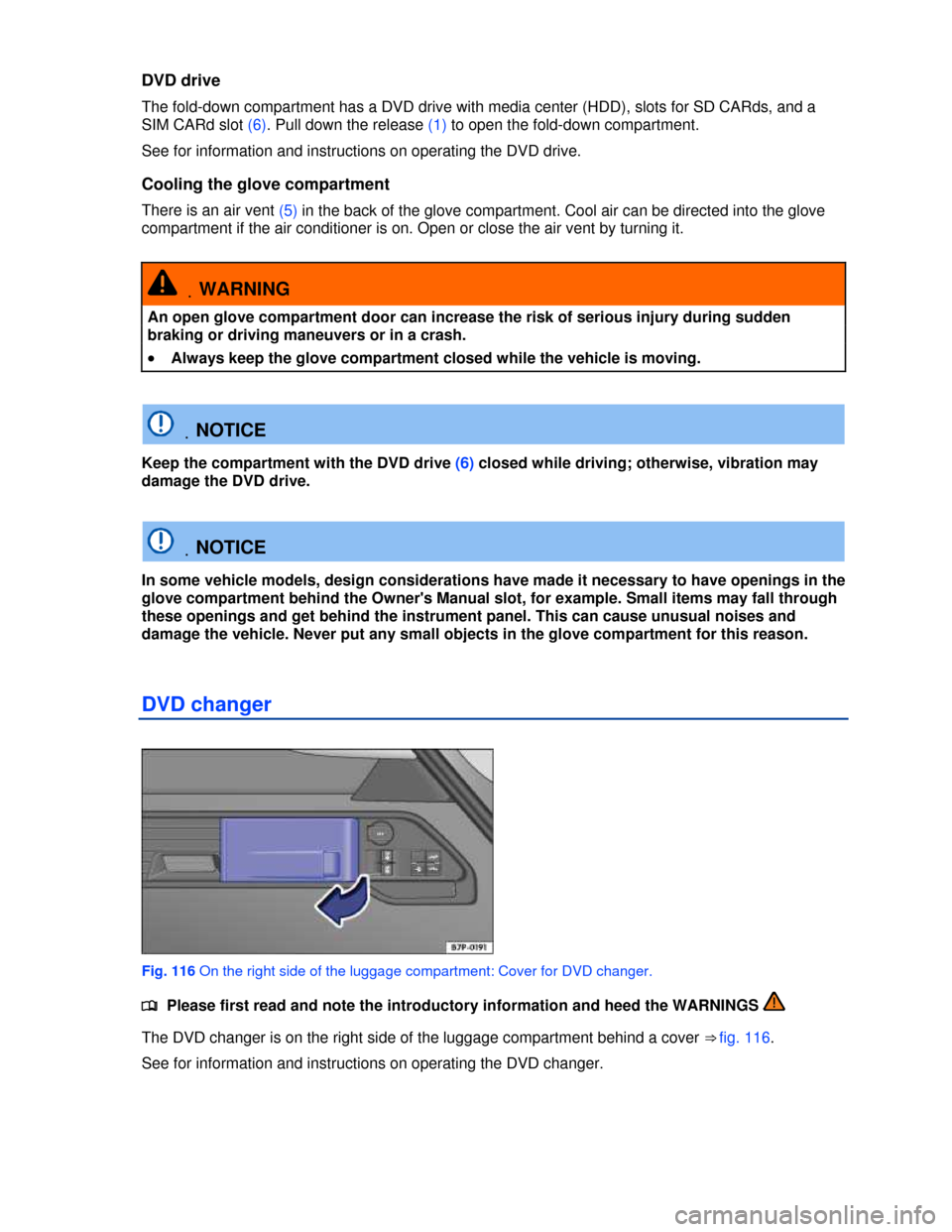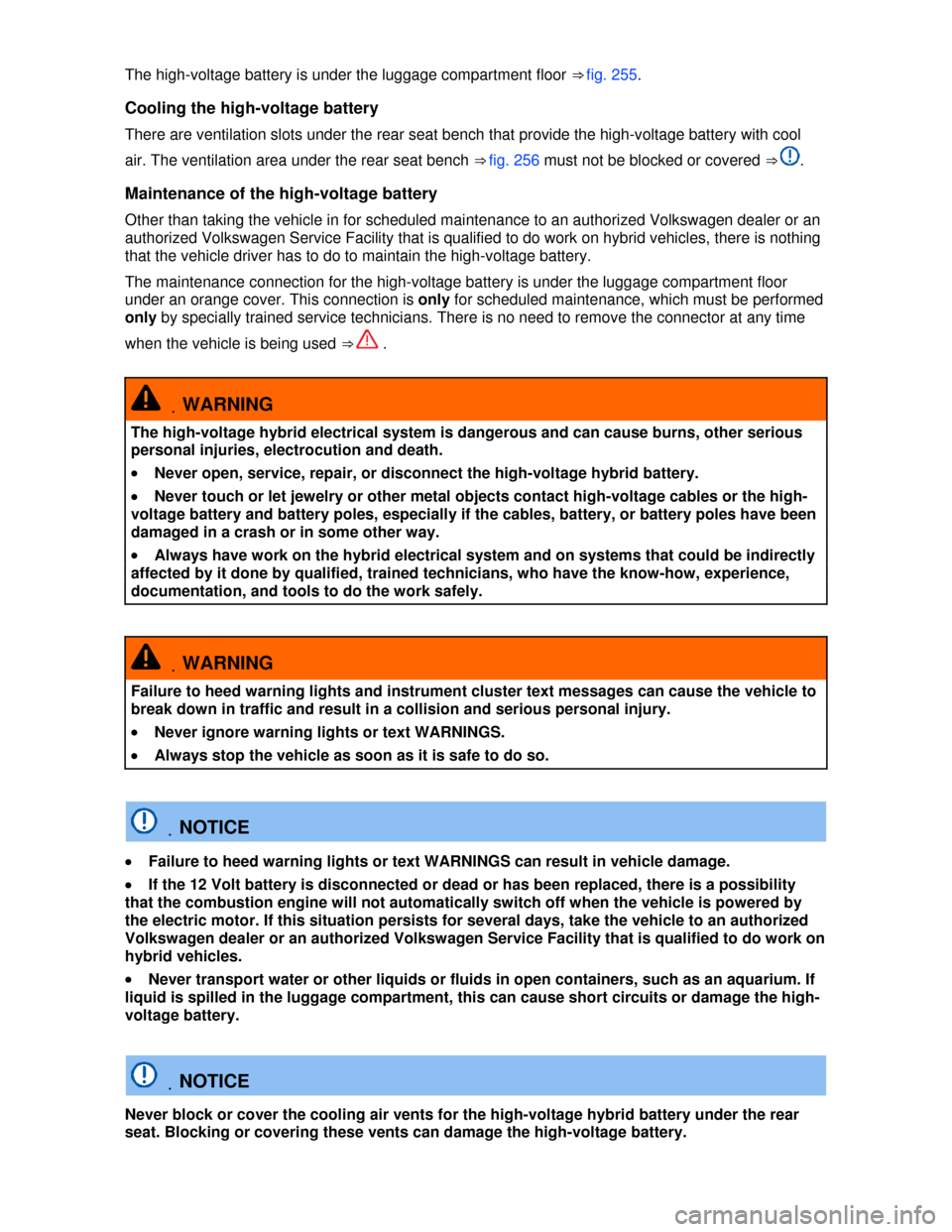Page 164 of 440

DVD drive
The fold-down compartment has a DVD drive with media center (HDD), slots for SD CARds, and a
SIM CARd slot (6). Pull down the release (1) to open the fold-down compartment.
See for information and instructions on operating the DVD drive.
Cooling the glove compartment
There is an air vent (5) in the back of the glove compartment. Cool air can be directed into the glove
compartment if the air conditioner is on. Open or close the air vent by turning it.
.WARNING
An open glove compartment door can increase the risk of serious injury during sudden
braking or driving maneuvers or in a crash.
�x Always keep the glove compartment closed while the vehicle is moving.
.NOTICE
Keep the compartment with the DVD drive (6) closed while driving; otherwise, vibration may
damage the DVD drive.
.NOTICE
In some vehicle models, design considerations have made it necessary to have openings in the
glove compartment behind the Owner's Manual slot, for example. Small items may fall through
these openings and get behind the instrument panel. This can cause unusual noises and
damage the vehicle. Never put any small objects in the glove compartment for this reason.
DVD changer
Fig. 116 On the right side of the luggage compartment: Cover for DVD changer.
�
Page 363 of 440

Driving
situations Requirements and conditions Vehicle behavior
– CAReful use of E-MODE button
⇒ fig. 251.
The high-voltage battery discharges quickly
with the E-MODE button switched on. This
can increase fuel consumption since driving
in electric mode is preferred in this case,
even though the combustion engine would
be more efficient.
Driving on
country roads
and highways.
– Conscious easing off of the
accelerator, to enable longer sailing
distance.
By easing off the accelerator, the
combustion engine is automatically
switched off and de-clutched. The vehicle
glides without engine power.
- Reducing speed by easing off the
accelerator early and not by
braking.
Sailing possible. Reduction of speed this
way is more fuel-efficient than through
braking.
- Avoid speeds of over about 160
km/h (99 mph).
Efficient sailing is possible with a speed of
about 160 km/h (99 mph) .
- CAReful selection of gear (S).
Sporty driving style with activated sport
programme increases fuel consumption.
Efficient sailing in sport programme with
combustion engine automatically switched
off is possible with a speed of about 70
km/h (43 mph).
Driving in cold
months.
- Do not warm up the combustion
engine by running it with the
vehicle stationary.
The temperature of the combustion engine
increases very slowly, but fuel consumption
increases considerably.
– CAReful use of heating for
windshield and the rear window,
outside mirror, seat and steering
wheel.
This prevents energy from being lost and
saves energy for the electric motor.
- Never leave the vehicle in a
garage over night.
This prevents the high-voltage battery and
the vehicle interior from cooling down too
much. The optimal temperature of the high-
voltage battery is reached quicker at the
beginning of the journey and the
combustion engine can be switched off
quicker when the vehicle interior is
sufficiently heated.
Page 368 of 440

The high-voltage battery is under the luggage compartment floor ⇒ fig. 255.
Cooling the high-voltage battery
There are ventilation slots under the rear seat bench that provide the high-voltage battery with cool
air. The ventilation area under the rear seat bench ⇒ fig. 256 must not be blocked or covered ⇒ .
Maintenance of the high-voltage battery
Other than taking the vehicle in for scheduled maintenance to an authorized Volkswagen dealer or an
authorized Volkswagen Service Facility that is qualified to do work on hybrid vehicles, there is nothing
that the vehicle driver has to do to maintain the high-voltage battery.
The maintenance connection for the high-voltage battery is under the luggage compartment floor
under an orange cover. This connection is only for scheduled maintenance, which must be performed
only by specially trained service technicians. There is no need to remove the connector at any time
when the vehicle is being used ⇒ .
.WARNING
The high-voltage hybrid electrical system is dangerous and can cause burns, other serious
personal injuries, electrocution and death.
�x Never open, service, repair, or disconnect the high-voltage hybrid battery.
�x Never touch or let jewelry or other metal objects contact high-voltage cables or the high-
voltage battery and battery poles, especially if the cables, battery, or battery poles have been
damaged in a crash or in some other way.
�x Always have work on the hybrid electrical system and on systems that could be indirectly
affected by it done by qualified, trained technicians, who have the know-how, experience,
documentation, and tools to do the work safely.
.WARNING
Failure to heed warning lights and instrument cluster text messages can cause the vehicle to
break down in traffic and result in a collision and serious personal injury.
�x Never ignore warning lights or text WARNINGS.
�x Always stop the vehicle as soon as it is safe to do so.
.NOTICE
�x Failure to heed warning lights or text WARNINGS can result in vehicle damage.
�x If the 12 Volt battery is disconnected or dead or has been replaced, there is a possibility
that the combustion engine will not automatically switch off when the vehicle is powered by
the electric motor. If this situation persists for several days, take the vehicle to an authorized
Volkswagen dealer or an authorized Volkswagen Service Facility that is qualified to do work on
hybrid vehicles.
�x Never transport water or other liquids or fluids in open containers, such as an aquarium. If
liquid is spilled in the luggage compartment, this can cause short circuits or damage the high-
voltage battery.
.NOTICE
Never block or cover the cooling air vents for the high-voltage hybrid battery under the rear
seat. Blocking or covering these vents can damage the high-voltage battery.
Page 369 of 440
.NOTICE
If the vehicle is not used for a longer period, the high-voltage battery will run down. To keep
the high-voltage battery in good condition, the vehicle needs to be driven at least every 2
months for at least 30 minutes or 15 miles (20 km).
�x If the high-voltage battery is dead, the gasoline engine will not start. Contact an authorized
Volkswagen dealer, an authorized Volkswagen Service Facility, or another qualified workshop
for assistance.
Special considerations for hybrid vehicles
Fig. 257 Warning label on high-voltage hybrid components (A). Warning label on covers which are over high-
voltage hybrid components (B).
Fig. 258 In the engine compartment: Coolant expansion tank, low temperature cooling circuit.
.�